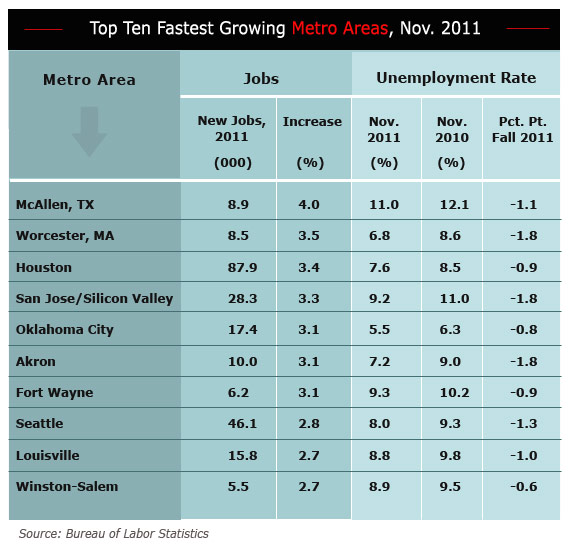The public image of McAllen, Texas, took a severe beating in 2009 when The New Yorker revealed the city had the highest health care costs in the nation. The magazine described a local medical culture that encouraged waste.
Now, McAllen, which borders Mexico, finally has something to cheer about. Over the past year, it has become the fastest growing region in the country, according to the monthly ranking of the nation’s 100 largest metro areas compiled by The Fiscal Times. McAllen and its neighboring towns added nearly 8,000 jobs or 4 percent to its total in the past year and reduced its unemployment rate by a full 1.1 percentage points, to 11 percent.
While unemployment there is still higher than the national average, the local economy is clearly on the mend, local officials say. It’s a trend that parallels much of the rest of the country, where the latest Bureau of Labor Statistics report showed that over two-thirds of the nation’s metro areas increased their payrolls in November compared to the prior month and 351 of 372 areas reduced their unemployment rates.
Nationally, the unemployment rate fell to 8.6 percent in November. The December rate will be released Friday.

McAllen’s recent growth was in part due to its vibrant – some would say overly vibrant – health care sector, local officials admitted. “We’ve had a huge growth in the medical industry,” said Steve Ahlenius, president of the McAllen Chamber of Commerce. “All the hospitals here are privately owned, for-profit hospitals. It will be interesting to see what will happen here over the next year as Medicaid and Medicare go through their cuts.”
But that’s not the only reason for the uptick in employment over the past year, Ahlenius said. The region is benefiting from its status as a gateway to Latin America and its youthful population. The median age in the region is just over 25.
In the past year, Brazil’s Santana Textiles, which manufacturers denim , opened a major facility and added 800 jobs in McAllen in order to get a foothold in the U.S. market. Looking to tap the young, children-of-immigrants workforce, the company plans to add another 400 jobs over the coming year.
Steelcase, an office furniture manufacturer based in Michigan, also opened a major operation in the area in the past year as well as a companion facility in Reynosa, which is just across the Mexican border. The company has already put management personnel in place and plans to go on a major hiring spree in the coming months to staff the new facility.
McAllen is also benefiting from the growth of the Mexican middle class, especially in nearby Monterey. “One third of our retail business here – the stores, the restaurants – comes from Mexico,” Ahlenius said. “They have a lot of money to spend.”
Meanwhile, changes in the rankings reveal what better times can mean for a city, and may be a harbinger for what lies ahead for the nation as a whole. Fort Wayne, which topped The Fiscal Times list the past two months, was still in seventh place, with 9,300 or 3.1 percent more jobs in November than it had the previous year. But its unemployment rate rose a full point to 9.3 percent in November because 7,000 more people were in the workforce than in the previous month.
This is precisely what economists say will happen when the pace of job formation picks up. Nationwide, the labor force fell by over 300,000 workers in November, as discouraged jobseekers gave up looking for work. But when jobs start appearing, as they have in Fort Wayne over the past year, many of those people return to the labor market, which results in a temporary upward blip in the unemployment rate.
Technology-oriented cities continued to do well in the rankings in November. The San Jose-Silicon Valley area fell one slot to number four, while Seattle, home to Microsoft, numerous software firms and some leading biotechnology firms, maintained its spot in the top ten, at number nine. Houston, the third best performing city, added the most jobs of any city in the nation: nearly 88,000.
“The energy sector has played a big role in its recent success, but it has also benefited from expanded trade through the Port of Houston and rapid growth in its large health and biosciences industry,” said Ray Perryman, a Waco-based economist whose consulting group studies the Lone Star State’s economy.
As for McAllen’s success, he says, “The area has had many periods in the past where it has been among the fastest growing regions in the country. The growth is driven by the relatively high growth occurring in nearby areas of Mexico, particularly in the manufacturing sector, as well as a recent pickup in commercial activity. The area has a young, rapidly growing, and relatively low-skilled workforce, which contributes to a seeming paradox of rapid growth in employment while the unemployment rate remains high.”
At the other end of the spectrum, the Deep South produced the most regions near the bottom in terms of job growth. In Georgia, Atlanta and Augusta have been hit hard by failing commercial real estate projects, while Richmond, Birmingham and Huntsville, Alabama, which have traditionally relied on low wages, low taxes and few social programs to spur growth, are lagging well behind the rest of the country, losing between one-half and one percent of their jobs in the past year.




